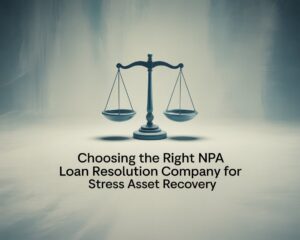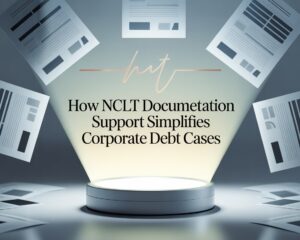One time settlement scheme (OTS) could be the savior for borrowers when their loan repayments begin to seem like an insurmountable mountain. For individuals and companies who find it hard to pay EMIs or loans owed to banks, this scheme presents a well-organized and win-win solution to end debts without intense involvement in accumulating interest and legal entanglements.
We will unravel the mystery of OTS settlement, its mode of operation, and why it may be a viable solution when you want to settle your bank loan effectively.
What Is a One Time Settlement Scheme?
A one time settlement scheme, also known as OTS settlement, is a debt settlement plan provided by banks to enable borrowers to clear their debts in a lump sum or through a structured payment.
In this plan, both the bank and the borrower agree to clear the loan account through a lump-sum payment, which is normally lower than the outstanding loan balance. After the borrower has paid the agreed amount, the account is marked as settled, and further recovery proceedings are closed by the bank.
In simple terms, it is a negotiated closure where both the bank and the borrower benefit, the borrower is relieved of the debt burden, while the bank recovers at least some of the dues instead of writing off the loan completely.
Why Do Banks Provide One Time Settlement Schemes?
Banks are generally not willing to settle loans below the actual amount due. However, in situations where recovery through ordinary means is unlikely, it becomes a practical business decision to initiate an OTS settlement.
This is why bank loan one time settlement schemes are preferred by financial institutions:
- To recover non-performing assets (NPAs): When a loan account takes longer than 90 days to recover, it becomes an NPA. The settlement helps banks recover money more quickly.
- To reduce legal and administrative expenses: Court cases and recovery processes can take years. An OTS helps conclude these matters faster.
- To refurbish balance sheets: Banks aim to show lower NPA ratios and better asset quality, especially during audits or regulatory inspections.
- To assist stressed borrowers: The one time settlement scheme is a goodwill initiative by many banks to help borrowers facing genuine financial hardship.
Who Is Qualified to Receive a One Time Settlement?
Eligibility depends on the internal policy of each bank. However, generally, the following categories of borrowers are eligible for a bank loan one time settlement:
- Borrowers of loans classified as NPAs.
- Borrowers whose financial situation or businesses are in extreme distress.
- Borrowers with stuck or disputed loans that are unlikely to be recovered.
- Accounts that have been written off but where the bank is willing to recover part of the dues.
Banks usually evaluate each case individually, assessing repayment history, business condition, and the borrower’s willingness to cooperate.
How Does a One Time Settlement Work?
The following is a rough summary of how an OTS settlement process typically works:
1. Borrower Initiation
The borrower approaches the bank, explains their financial situation, and expresses the intent to settle the loan.
2. Proposal Submission
A written proposal is submitted, indicating:
- The amount the borrower can pay
- The repayment timeline
- The rationale behind the offer
3. Bank Evaluation
The bank evaluates the loan history, current financial position, available security, and recoverable amount.
If the offer appears reasonable, the bank forwards it for approval.
4. Negotiation and Agreement
The settlement amount is discussed and finalized between both parties. This amount is usually lower than the total outstanding balance but fair enough for both sides.
5. Payment and Closure
After approval, the borrower makes the agreed payment within the stipulated period. Once the payment is completed, the bank issues a loan settlement letter, and the account is classified as paid and closed.
Types of One Time Settlement Schemes
Banks often design various OTS schemes to fit different borrower categories. The most common types include:
1. Personal Loan OTS
For individuals with personal loans, credit card dues, or consumer loans. The bank offers to settle the outstanding balance for a reduced lump sum.
2. Business Loan OTS
Applicable for MSMEs or business borrowers whose operations have suffered. The bank may offer flexible repayment timelines.
3. Housing Loan OTS
For borrowers unable to continue EMIs due to job loss or income reduction. This helps avoid foreclosure or auction of the property.
4. Agricultural Loan OTS
Common in rural and farming sectors where crop failure or natural disasters affect repayment capacity.
Each one time settlement scheme is customized based on the borrower’s segment and repayment potential.
Key Benefits of One Time Settlement Schemes
Choosing an OTS settlement can provide several advantages, both financially and psychologically.
1. Debt Relief
The most obvious benefit, it allows borrowers to close a heavy loan burden by paying a reduced amount, giving them a fresh start.
2. Avoids Legal Action
Settling prevents banks from initiating recovery under SARFAESI or dragging the borrower into long court battles.
3. Protects Assets
If the borrower has pledged property or collateral, settlement can prevent its seizure or auction.
4. Faster Resolution
Compared to litigation or restructuring, an OTS ensures quicker closure, often within months.
5. Improved Mental Peace
Clearing dues, even partially, restores confidence and provides relief from constant financial stress.
Drawbacks You Should Consider
While one time settlement schemes sound appealing, borrowers must also understand the implications.
1. CIBIL Impact
Settled accounts are marked as “settled” in credit reports, not “closed.”
This can lower your credit score, making future loans more difficult to secure.
2. No Interest Waiver Guarantee
Banks may not waive the entire interest component; some insist on partial interest recovery.
3. Not for All Loans
Active or standard accounts may not qualify for OTS, as banks prefer recovering full dues from performing accounts.
4. One-Time Opportunity
Once you accept a settlement, you cannot reopen the loan or request restructuring later.
That’s why it’s wise to evaluate your financial condition carefully before opting for OTS settlement.
Documents Required for One Time Settlement
When applying for a bank loan one time settlement, the borrower typically needs to submit:
- A written settlement request letter to the bank.
- Proof of financial hardship (e.g., income loss, business downturn).
- Account statements and loan documents.
- Bank ID proof and PAN card.
- Supporting documents for the proposed settlement amount (e.g., valuation reports, cash flow statements).
Banks may ask for additional papers depending on the loan type and amount involved.
How to Negotiate an Effective Settlement
Negotiation plays a crucial role in achieving a favorable one time settlement. Here are practical tips to strengthen your case:
1. Be Transparent
Honesty about your financial situation builds trust. Banks are more likely to cooperate with transparent borrowers.
2. Show Willingness to Pay
Even if your offer is lower, demonstrate intent to settle, perhaps by paying an initial amount upfront.
3. Back Your Proposal with Data
Use documents like income statements or audit reports to justify your offer.
4. Involve a Debt Consultant
Professional advisors can guide you in drafting proposals and negotiating better terms.
5. Request a Clean Settlement Letter
After payment, ensure the bank issues an official No Dues Certificate and updates the credit bureau accordingly.
Government Guidelines and OTS Frameworks
The Reserve Bank of India (RBI) periodically issues guidelines for one time settlement schemes to ensure fair and transparent practices.
Key highlights include:
- Banks must frame board-approved OTS policies for NPA accounts.
- Settlements should not discriminate between borrowers with similar profiles.
- Settlement terms must be well-documented, and approval must follow due diligence.
- Any OTS settlement involving substantial write-offs must be reported to the bank’s top management and the RBI.
Public sector banks (PSBs) also launch periodic OTS campaigns, encouraging borrowers to clear long-pending dues at concessional terms.
Difference Between Loan Restructuring and One Time Settlement
| Aspect | Loan Restructuring | One Time Settlement |
|---|---|---|
| Objective | Helps borrower continue repayment | Closes loan account permanently |
| Method | Changes tenure, EMI, or interest rate | Lump-sum payment for reduced amount |
| Credit Impact | Retains “standard” status if repaid | Marked as “settled” in CIBIL |
| Eligibility | Active borrowers | NPA or default accounts |
| Bank’s Recovery | Full principal with modified terms | Partial recovery |
Understanding this distinction helps borrowers choose what’s best based on their current position and repayment ability.
Can You Apply for OTS Online?
Yes. Many banks today allow online applications for one time settlement schemes. Borrowers can visit their bank’s official website or contact the Nodal Recovery Officer to submit their proposal digitally.
Once reviewed, the bank informs the applicant about next steps, documentation, and payment timelines.
Best Practices Before Opting for One Time Settlement
Before finalizing an OTS, consider these crucial points:
- Evaluate your finances honestly. Make sure the settlement amount is realistic.
- Get everything in writing. Verbal promises hold no legal value.
- Verify the final amount. Check if it includes penalties or interest.
- Understand post-settlement credit implications. Your credit report will reflect “settled” status.
- Keep records safely. Retain all letters, payment receipts, and confirmation emails.
By staying proactive, you can ensure the bank loan one time settlement works in your favor.
Future After Settlement, Rebuilding Credit
After closing a loan under OTS, the next step is to rebuild your creditworthiness.
Here’s how:
- Pay future EMIs on time.
- Avoid multiple loan applications immediately after settlement.
- Keep credit utilization below 30%.
- Check your credit report regularly to ensure the “settled” tag updates correctly.
- Maintain a small secured credit card or loan and repay on time to rebuild trust with lenders.
With consistent discipline, borrowers can recover their financial credibility within a few years.
Conclusion
A one time settlement scheme can be a powerful tool for borrowers who genuinely wish to close their overdue accounts and start afresh. However, it’s not a quick fix, it demands financial honesty, negotiation clarity, and strategic planning.
When handled well, OTS settlement helps you move from debt distress to financial stability while allowing banks to recover funds that might otherwise remain stuck indefinitely.
FAQs
What is the purpose of a one time settlement scheme?
A one time settlement scheme helps borrowers clear their pending bank loans through a mutually agreed payment that’s lower than the total outstanding balance. It allows banks to recover dues faster while giving borrowers relief from prolonged debt pressure.
Is one time settlement good for borrowers?
Yes, opting for a one time settlement can be beneficial for borrowers struggling with repayments. It helps avoid legal action and stops interest from piling up. However, it may slightly affect your credit score since the account is marked as “settled” instead of “closed.”
How can I apply for a bank loan one time settlement?
To apply for a bank loan one time settlement, you need to approach your bank, explain your financial hardship, and submit a written proposal detailing the amount you can pay. The bank will evaluate your case before approving the settlement.
What types of loans are eligible for OTS settlement?
Most secured and unsecured loans can qualify for OTS settlement, including personal loans, business loans, and home loans. Eligibility depends on the bank’s internal policies and the borrower’s repayment history.
How is the settlement amount decided?
The settlement amount in a one time settlement scheme is determined after negotiations between the bank and the borrower. Factors like the borrower’s repayment capacity, collateral value, and financial status are considered before finalizing the amount.
Does one time settlement affect my credit score?
Yes, after a one time settlement, the account is marked as “settled” in your credit report. While this indicates partial repayment, it can impact your credit score for a few years. Still, it’s often better than having an unpaid or defaulted account.








